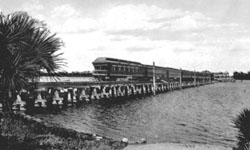|
|
Ormond Beach's first residents
 date back 12,000 years to the ancient Indians who hunted along the Halifax and Tomoka Rivers. They left behind evidence of their lives in the way of mounds and artifacts, such as broken pottery, arrowheads, spear points, and evidence that they ate oysters and clams. By the early 1500s, the Timucuan Indians, one of five Indian tribes in Florida, made the Ormond Beach area their home. Fortunately, quite a lot is known about them largely in part to the detailed diaries and drawings of French explorer, Jacques LeMoyne. Their village, known as Nocoroco, is thought to have been located at the site of present day Tomoka State Park. War and disease eventually saw the decline of the Timucuan Indian tribe. date back 12,000 years to the ancient Indians who hunted along the Halifax and Tomoka Rivers. They left behind evidence of their lives in the way of mounds and artifacts, such as broken pottery, arrowheads, spear points, and evidence that they ate oysters and clams. By the early 1500s, the Timucuan Indians, one of five Indian tribes in Florida, made the Ormond Beach area their home. Fortunately, quite a lot is known about them largely in part to the detailed diaries and drawings of French explorer, Jacques LeMoyne. Their village, known as Nocoroco, is thought to have been located at the site of present day Tomoka State Park. War and disease eventually saw the decline of the Timucuan Indian tribe.
 King Ferdinand VII of Spain commissioned an Anglo-Irish-Scotch sea captain named James Ormond I to bring Franciscan settlers to this area of Florida in the early 1800s. At that time, the region was largely occupied by large sugar mill plantation owners. However, the second Seminole War (1835-1842) brought about the destruction of most of those plantations. By 1854, when Volusia County was created, approximately 20 families were here. Slowly over time, new families arrived, including a group from New Britain, Connecticut, who started a retirement community on the west bank of the Halifax River. They also called this new town New Britain. In 1880 the city was incorporated, and the name was changed to Ormond Beach in honor of its’ earliest settler, James Ormond I. Two other early settlers named John Anderson and Joseph Downing built the Hotel Ormond in 1888. Then, the railroad arrived in town, and a railroad bridge was built across the Halifax River that could discharge passengers right in front of the hotel. There were also river cruises that departed from the town that served picnic lunches and ice cream to the passengers in their cabins. The town was booming. King Ferdinand VII of Spain commissioned an Anglo-Irish-Scotch sea captain named James Ormond I to bring Franciscan settlers to this area of Florida in the early 1800s. At that time, the region was largely occupied by large sugar mill plantation owners. However, the second Seminole War (1835-1842) brought about the destruction of most of those plantations. By 1854, when Volusia County was created, approximately 20 families were here. Slowly over time, new families arrived, including a group from New Britain, Connecticut, who started a retirement community on the west bank of the Halifax River. They also called this new town New Britain. In 1880 the city was incorporated, and the name was changed to Ormond Beach in honor of its’ earliest settler, James Ormond I. Two other early settlers named John Anderson and Joseph Downing built the Hotel Ormond in 1888. Then, the railroad arrived in town, and a railroad bridge was built across the Halifax River that could discharge passengers right in front of the hotel. There were also river cruises that departed from the town that served picnic lunches and ice cream to the passengers in their cabins. The town was booming.
One of Ormond Beach’s most famous residents was John D. Rockefeller. It’s said that he was determined to live to be 100 years old and sent his employees out to find the most “pollution-free” place to spend his retirement. They reported back to him - they’d found the perfect place in Ormond Beach. So, in 1914, Rockefeller arrived at the Ormond Hotel and rented an entire floor. He did this for four winter seasons, and then purchased a home built by Reverend Harwood Huntington, whose wife was the daughter of the creator of the Pullman Train Car Company. Rockefeller‘s home "The Casements," was located only a few hundred yards south of the Ormond Hotel. Many famous people came to visit, including Henry Ford and Will Rogers, and each winter he held the annual Rockefeller Christmas Party at the Casements. John D. Rockefeller didn’t make it to 100, but he was close - he died in 1937 at age 97. His home was sold by the family in 1939. In 1973, it was purchased by the City of Ormond Beach, and after restoration, it serves as a cultural and community center.
In 1980, the city of Ormond Beach celebrated its’ centennial with a parade, pageant and other special events. The city is still thriving today. According to the local Chamber of Commerce, Ormond Beach was recently rated “one of the top 100 cities to relocate by National Strategy Group, and it’s also been designated as “one of the top 10 places to retire in an edition of "Where to Retire" magazine.”
Photo of the Palm Beach Limited Train courtesy: State Archives of Florida, Florida Memory
|
|
|